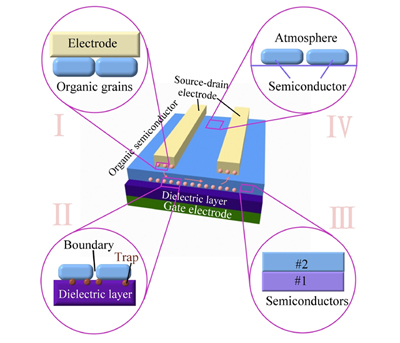Interface Engineering: An Effective Approach toward High-Performance Organic Field-Effect Transistors
CHONG-AN DI, YUNQI LIU,* GUI YU, AND DAOBEN ZHU
Beijing National Laboratory for Molecular Sciences, Key Laboratory of Organic Solids, Institute of Chemistry, Chinese Academy of Sciences, Beijing 100190, P. R. China
By virtue of their excellent solution processibility and flexibility, organic field-effect transistors (OFETs) are considered outstanding candidates for application in low-cost, flexible electronics. Not only does the performance of OFETs depend on the molecular properties of the organic semiconductors involved, but it is also dramatically affected by the nature of the interfaces present. Therefore, interface engineering, a novel approach towards high-performance OFETs, has attracted considerable attention. In this Account, we focus on recent advances in the study of OFET interfaces including electrode/organic layer interfaces, dielectric/organic layer interfaces, and organic/organic layer interfaces that have resulted in improved device performance, enhanced stability, and the realization of organic light-emitting transistors.
The electrode/organic layer interface, one of the most important interfaces in OFETs, usually etermines the carrier injection characteristics. Focusing on OFETs with copper and silver electrodes, we describe effective modification approaches of the electrode/organic layer interfaces. Furthermore, the influence of electrode morphology on device performance is demonstrated. These results provide novel approaches towards high-performance, low-cost OFETs.
The dielectric/organic layer interface is a vital interface that dominates carrier transport; modification of this interface therefore offers a general way to improve carrier transport accordingly. The dielectric layer also affects the device stability of OFETs. For example, high-performance pentacene OFETs with excellent tability are obtained by the selection of a dielectric layer with an appropriate surface energy.
The organic/organic layer interface is a newly investigated topic in OFETs. Introduction of organic/organic layer interfaces, such as heterojunctions, can improve device performance and afford ambipolar OFETs. By designing laterally arranged heterojunctions made of organic field-effect materials and light-emitting materials, we realized both light emission and field effects simultaneously in a single OFET.
The preceding decade has seen great progress in OFETs. Interface engineering provides a simple but effective approach toward creating high-performance OFETs and will continue to make essential ontributions in the development of useful OFET based devices. The exploration of novel interface engineering pplications also merits further attention; the design of gas sensors through a more complete understanding of interface phenomena serves as just one example.
ACCOUNTS OF CHEMICAL RESEARCH, 2009, Vol. 42, No. 10, 15731583






